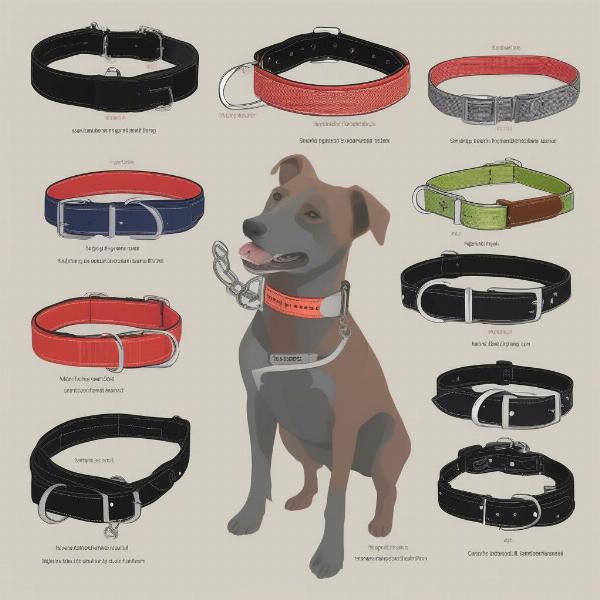Choosing the right collar for a large breed dog is about more than just aesthetics. It’s a crucial decision that impacts their comfort, safety, and overall well-being. Large breed dog collars need to be durable enough to withstand the strength of these powerful dogs, while also being comfortable for everyday wear. This article will guide you through the process of selecting the perfect large breed dog collar, ensuring a happy and safe experience for both you and your furry companion.
Key Considerations When Choosing Large Breed Dog Collars
When selecting a collar for your large breed dog, several factors need to be considered. Size, material, and style are all crucial elements that contribute to both the collar’s functionality and your dog’s comfort.
Size and Fit: A Perfect Balance
Getting the right size is paramount. A collar that’s too tight can restrict breathing and cause discomfort, while one that’s too loose can easily slip off. Measure your dog’s neck circumference and add two inches to determine the appropriate collar size. Always check the manufacturer’s sizing chart for specific recommendations. For growing puppies, choose an adjustable collar to accommodate their rapid growth spurts.
Material Matters: Durability and Comfort Combined
Large breed dogs are known for their strength, so the collar material needs to be robust and durable. Leather, nylon, and biothane are all popular choices for their strength and resilience. Consider your dog’s lifestyle and activity level when choosing a material. If your dog loves swimming, a waterproof material like biothane is a good option.
Style and Functionality: Beyond the Basics
While functionality is key, style shouldn’t be overlooked. Martingale collars are an excellent choice for dogs prone to pulling, as they tighten gently when the leash is pulled, preventing escape. Flat collars are a classic and versatile option for everyday wear. Consider features like reflective strips for enhanced visibility during nighttime walks.
Different Collar Types for Large Breeds
The vast array of collar types available can be overwhelming. Here’s a breakdown of common types and their suitability for large breeds:
- Flat Collars: The standard and most versatile option, suitable for well-behaved dogs who don’t pull excessively.
- Martingale Collars: Ideal for dogs that tend to pull, providing gentle control without choking. dog collars for large breed dogs
- Prong Collars: These collars should only be used under the guidance of a professional trainer due to their potential to cause harm if used incorrectly.
- Head Halters: A good option for strong pullers, providing control by gently steering the dog’s head.
Ensuring Your Dog’s Comfort and Safety
Once you’ve chosen the perfect collar, proper fit and ongoing maintenance are essential.
Checking the Fit: Two-Finger Rule
A well-fitted collar should allow you to comfortably slip two fingers between the collar and your dog’s neck. Regularly check the fit, especially for growing puppies.
Cleaning and Maintenance: Prolonging Collar Lifespan
Clean your dog’s collar regularly to prevent the buildup of dirt and bacteria. The cleaning method depends on the material; leather collars require specific leather cleaners, while nylon collars can be hand-washed.
Commonly Asked Questions About Large Breed Dog Collars
- What is the best collar for a large breed dog that pulls? Martingale collars are often recommended for large breed dogs that pull, as they offer gentle control without choking. Head halters are another option.
- How do I measure my dog for a collar? Measure the circumference of your dog’s neck with a flexible tape measure and add two inches.
- What material is best for a large breed dog collar? Leather, nylon, and biothane are all durable options. Consider your dog’s lifestyle and activity level when choosing.
- How often should I clean my dog’s collar? Clean the collar regularly, ideally every few weeks or as needed, to prevent the buildup of dirt and bacteria.
- Can a collar be too tight for my dog? Yes, a collar that’s too tight can restrict breathing and cause discomfort. Always ensure you can fit two fingers between the collar and your dog’s neck.
- What are some signs that my dog’s collar is too tight? Signs of a too-tight collar include difficulty breathing, chafing, and excessive scratching around the neck area.
- Are prong collars safe for large breed dogs? Prong collars should only be used under the guidance of a professional trainer due to the potential for harm if used incorrectly.
 Different Types of Dog Collars
Different Types of Dog Collars
Conclusion: Investing in the Right Collar
Selecting the right collar for your large breed dog is a crucial investment in their comfort, safety, and well-being. By considering factors like size, material, and style, you can find the perfect fit for your gentle giant. Remember to regularly check the fit and maintain the collar to ensure its longevity. With the proper collar, you and your furry friend can enjoy countless walks and adventures together. Don’t forget to check out our articles on dog collars xxl and dog natural tick repellent for more information on keeping your large breed dog safe and healthy.
ILM Dog is your one-stop resource for all things dog-related. We offer expert advice on breed selection, health care, training, nutrition, grooming, and much more. Whether you’re a seasoned dog owner or just starting your journey, ILM Dog provides the information you need to provide the best possible care for your canine companion. Contact us today for personalized advice and support! Email: [email protected], Phone: +44 20-3965-8624.